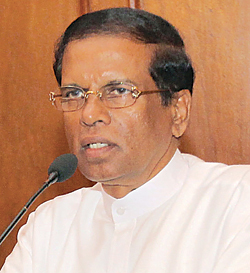INDIAN ARMED FORCES CHIEFS ON
OUR RELENTLESS AND FOCUSED PUBLISHING EFFORTS

SP Guide Publications puts forth a well compiled articulation of issues, pursuits and accomplishments of the Indian Army, over the years

I am confident that SP Guide Publications would continue to inform, inspire and influence.

My compliments to SP Guide Publications for informative and credible reportage on contemporary aerospace issues over the past six decades.
- Prime Minister witnesses 'Bharat Shakti' – a Tri-Services Firing and Manoeuvre Exercise in Pokhran, Rajasthan
- Interim Defence Budget 2024-25 — An Analysis
- Union Defence budget 2024
- Prime Minister Modi Commemorates Indian Navy Day in a Grand Ceremony
- Prime Minister Modi Flies in the LCA Tejas
- New Chapter in India-Italy Defence Ties
- Airpower beyond Boundaries
Change of guard in Sri Lanka
China’s investments in Sri Lanka are part of her plan to establish port facilities in the IOR in garb of commercial activity, where Chinese Navy vessels can start berthing for ‘rest and recoup’.
 |
By Lt. General P.C. Katoch (Retd) Former Director General of Information Systems, Indian Army |
January 2015 saw the change of guard in Sri Lanka with new President Maithripla Sirisena and new Prime Minister Ranil Wikramasinghe, latter having held the same post earlier —he was Sri Lanka’s Prime Minister from May 1993 to April 1994 and then from December 2001 to April 2004.

That former President Mahinda Rajapaksa was double timing India with a heavy tilt towards China was quite obvious. Rajapaksa’s first visit abroad as Prime Minister was also to China. In an interview with Indian media, the new Prime Minister Ranil Wickremasinghe has said that his government will redress the pro-China tilt of the previous regime under Rajapaksa who played the China card to India and the West.
Under the Rajapaksa regime, China invested an estimated $6 billion in Sri Lanka, some of it in strategic infrastructure projects like ports and airports; China has invested $4 billion in infrastructure projects since 2009, lent $490 million in 2012 and committed another $1.6 billion last year. Wickremasinghe says his government will be scrutinising all such foreign and local contracts and action will be taken wherever corruption is found. The review includes the Colombo Port City project launched during Chinese President Xi Jinping’s visit to Sri Lanka last year.
Recalling the efforts made by Wickramasinghe during his two previous tenures as Prime Minister to strengthen relations with India, Prime Minister Narendra Modi said he believes future work with the new Sri Lankan Prime Minister will bring the two countries even closer. Sri Lanka’s new Foreign Minister Mangala Samaraweera visited New Delhi on January 18 and has met Indian Prime Minister, External Affairs Minister and the the National Security Advisor. Samaraweera said he was in India “to restore ties that were somewhat strained in the last few years.” That Samaraweera chose to travel to India less than a week after a new cabinet was installed in Sri Lanka indicates the shifting priorities in Colombo. Prime Minister Wickramasinghe too has said that the new government will take an even-handed approach and balance its relations with the two friendly neighbours China and India.
On January 21, 2015, Sri Lanka and India exchanged fishermen detained by each at the International Maritime Boundary Line (IMBL) off Kankasanthurai; 10 Sri Lankan fishermen with two boats and 15 Indian fishermen were exchanged. Foreign Minister Samaraweera said Sri Lanka will work upon returning balance about 87 boats seized by Sri Lankan authorities.
China’s investments in Sri Lanka are part of her plan to establish port facilities in the IOR in garb of commercial activity, where Chinese Navy vessels can start berthing for ‘rest and recoup’. Similar activity is on in Myanmar, Bangladesh, Seychelles, with Gwadar in Pakistan in close proximity of the strategic Strait of Hormuz. These ports are developed at costs that the host country will not be able to repay the loan for decades. So, China will extract the repayment in strategic terms—typical case of the proverbial camel’s head inside the tent. Why else would China invest $500 million in the Colombo International Container Terminal (CICT) if not for using it for military purposes when required? Not without reason a Chinese nuclear propelled submarine with escort warship docked at Colombo last November.
China’s obduracy is reflected in the secret memorandum issued by the People’s Liberation Army (PLA) General Logistic Department Director, saying “We can no longer accept the Indian Ocean as only an ocean of the Indians...We are taking armed conflicts in the region into account.” This, despite India never said Indian Ocean belongs to India. Significantly, all Chinese projects have PLA troops under garb of development workers, technicians, etc, Hambantota reported having one company of PLA.
Getting back to Indo-Sri Lanka relations, signals emanating from Sri Lanka to rebalance foreign relations augur well for India, even as China can be expected to continue investing in Sri Lanka.
President Sirisena is scheduled to visit India next month, his first visit abroad after becoming President. It is also understood that a reciprocal visit by Prime Minister Narendra Modi to Sri Lanka will follow closely thereafter. This would be visit of an Indian Prime Minister to Sri Lanka 28 long years after Rajiv Gandhi in 1987. Such high level visit would surely help improve relations including progressing the vexed issue of devolution of powers to Sri Lankan Tamils under the 13th amendment of the Sri Lankan Constitution.





